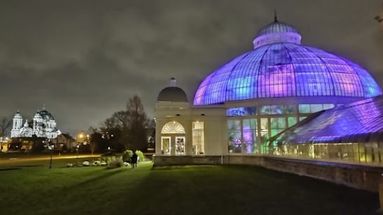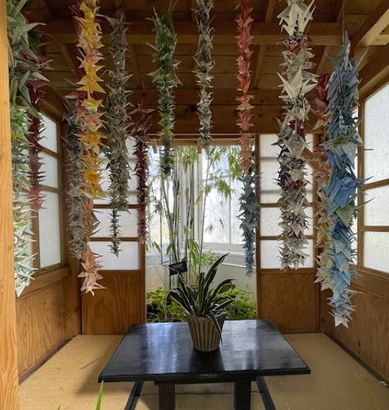
Buffalo and Erie County Botanical Gardens sits on 11 acres of vast landscape with strikingly beautiful gardens. It places special emphasis on raising awareness about nature by displaying non-native plants year-round. The facility has been under threat of closure because of blizzards and low public turnout. But the Buffalo and Erie County Botanical Gardens have always come through despite the ups and downs.
History
Renowned landscape architect Fredrick Law Olmsted, Sr., was called upon by the Buffalo Parks Commission in 1868 to design its parks. Olmsted designed three parks, The Park, The Parade, and the Front Park. After the expansion of Buffalo, Olmsted was asked to add more parks which led to the construction of South Park and Cazenovia Park.
His final design included a conservatory and surrounding formal gardens. South Park houses many botanical gardens. According to Olmsted’s design, the conservatory was supposed to show tropical plant species while the rest of the park would show hardy species in various facilities including an arboretum, bog garden, shrub garden, and pinetum.
After much careful planning and deliberation, the gardens were opened to the public in 1900. The gardens are shrouded by a towering glass structure, a Victorian-era conservatory, designed by Lord & Burnham.
The Gardens

Inside the Buffalo Botanical Gardens, you will find a wide range of plants that are found in different climates. Watching these plants co-exist outside their habitats is a sight to behold. You will see plants from the coldest places in the world thriving in the garden.
The sheer variety of plants makes the Gardens the perfect place to escape the winter months. The interior gardens have a total of 12 gardens, or houses, as they are referred to in the maps. They are located in three large domed rooms and small greenhouses.
The most stunning room in the Gardens is the Palm Dome, which will serve as your main entrance to the gardens. Palm Dome towers over everything at a height of 67 feet and houses large palm trees. Seeing palm trees grow in New York is a rare sight indeed.
The room is well lit and beautiful because the ceilings are made of glass panels. This allows natural sunlight to flow in and makes the area feel more spacious. Visitors can tour the gardens in a counterclockwise direction that starts and ends in the Palm Dome.
The central dome leads visitors into two areas that are filled with waterways and showy rainforest plants. The ponds are filled with wildlife such as koi that are fun to look at. A small waterflow decorates the Asian Rainforest garden.
Passing through each garden will take you through all sorts of cacti, carnivorous plants, bonsai, and many other areas. Information signs allow visitors to learn more about the garden and the plants featured in the houses.
On the other side of the gardens, visitors will find various artifacts and artwork from around the world.
There is an outdoor and indoor children’s garden in this area with many interactive structures and colorful horticulture treasures. These areas may be closed to the public depending on the time of year.
A major highlight of the gardens is the Florida Everglades House. This space is uniquely designed with alligator sculptures, a massive fish pond, and a boardwalk. In addition to indoor exhibit areas, there are many outdoor spaces at the Buffalo Botanical Gardens. They are fun to explore after you’re done checking out the indoor gardens.
However, the outdoor gardens are only filled with native plants that you would find in New York. The interior gardens are coated with a protective shade to manage the temperature of the plants. This feature is not available to plants in outdoor gardens.
Must visit gardens
House 4 – Cacti and Succulents
House 4 includes one of the biggest varieties of succulents found in North American deserts, such as the giant cacti. Other highlights include euphorbia, sansevierias, and lithops, as well as a unique collection of succulents from South Africa.
Most visitors visit the unique Barrel Cactus. These cacti live, native to American deserts, and have a large cylindrical shape that can store a lot of moisture. The plants are shrouded in large and thick spines that shield them from predators that might try to eat them.
Then there is the prickly pear cactus which is also unique to the dry regions of the Americas. These plants are very drought tolerant and can grow in cooler regions. Certain species of prickly pears produce edible fruit. Eating the fruit is no walk in the park you first have to remove its sharp spines.
House 5 – Ivy, Carnivorous Plants & Medicinal Garden
Buffalo and Erie County Botanical Gardens is said to have the largest ivy collection in the world. Major highlights of the interior garden include bonsai, herbs, flowering plants, and a Medicinal Garden. The Medicinal Garden is made possible by the efforts of Mercy Hospital and was created to educate people about how plants contribute to our ecosystems.
Specious plants in House 5 include fly traps, sundews, pitcher plants, and others. These terrifying carnivorous plants can be deadly to insects, spiders, and small rodents. Take a detour around House 5 to learn how these plants lure in unsuspecting prey to their demise.
House 12 – Florida Everglades
Florida Everglades is an immersive exhibit that highlights the importance of the wetlands, the earth’s natural water filtration system. Highlights of Florida Everglades include mangrove trees, a vivarium, a honey bee observation hive, and various native habitats.
They house red mangroves, one of 50 species, found across tropical and subtropical areas of the world. They are found in wetlands and also thrive in brackish water.
Wrapping Up
The Buffalo and Erie County Botanical Gardens is a stunning place to visit. It also gives you a chance to see all kinds of plants that you would otherwise not find in the New York landscape. The only criticism of the plants is that they are a bit small and it will take you just 1 hour to explore the entire space.
